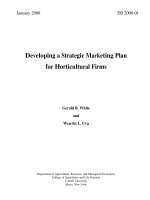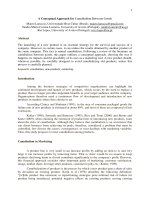A Brief Stock Market HistoryRobin R. Speziale pot
Bạn đang xem bản rút gọn của tài liệu. Xem và tải ngay bản đầy đủ của tài liệu tại đây (358.98 KB, 11 trang )
A Brief Stock Market History
Robin R. Speziale
***
Published by Robin R. Speziale at Smashwords
Copyright 2012 Robin R. Speziale
***
Author of Lessons From The Successful Investor:
Lessons From The Successful Investor is the new investing classic of our time. With thousands
of downloads, this new investing eBook has topped bestseller lists across major digital book
stores and has received rave reviews. Now available for only $4.99. The new investing classic
contains 85 timeless lessons to help you build a quality portfolio of value stocks that will make
you wealthy.
Reader Reviews - Lessons From The Successful Investor:
“This book is an absolute must for all new and inexperienced investors”
“This book has given me the confidence to be able to manage my own portfolio”
“I downloaded your book and could not stop reading it until the end”
“I have been reading many books on investing in the last while and by far this has provided the
most insight”
“I have the Ben Graham book but you have made it make sense”
“Incredibly informative and really motivated me to drive the inner investor I always knew was
inside me”
"Finally a book with easy to follow stock principles"
Other Titles by Robin R. Speziale:
The 85 Investing Lessons
The Investing Starter Guide
The Investor’s Checklist
The TFSA Guide
***
Contents
INTRODUCTION
Chapter 1 - MARKET HISTORY
***
A Brief Stock Market History
Based on Lessons From The Successful Investor
***
Introduction
Lessons from The Successful Investor has been a surprise success. I wrote Lessons From The
Successful Investor immediately after graduating from the University of Waterloo, having been
constantly asked by friends, family, co-workers and acquaintances to consolidate my value
investing knowledge into a neat package for easy consumption. That said, the summer of 2010
consisted of researching, writing, and editing Lessons From The Successful Investor, which
finally launched September 1, 2010 across major digital book stores. Initially, downloads of the
eBook trickled in. However, my value investing speaking appearance at the University of
Toronto, coupled with select media coverage, catapulted Lessons From The Successful
Investor to the top of major digital book stores. And at that point, downloads started pouring in
followed by wonderful feedback from readers, aspiring value investors, around the world. A
reader review that struck me was from a gentleman based in Portland, Oregon, who proudly
exclaimed, “I have the Ben Graham book but you have made it make sense”. You see, Ben
Graham is the father of value investing, author of The Intelligent Investor, and my investing idol.
That was a turning point for me. I started touring Canadian Universities, spreading the value
investing lessons from Lessons From The Successful Investor. I compiled brand new investing
eBooks in 2012. And I started consulting individuals on value investing principles. At the end of
the day, what makes me happy is when readers like you benefit from my value investing
lessons. Indeed, Lessons From The Successful Investor is the investing classic of our time,
containing 85 timeless lessons to help you build a quality portfolio of value stocks that will make
you wealthy. Once you finish reading this eBook, I hope you download the original Lessons
From The Successful Investor and find out for yourself what aspiring value investors around the
world are raving about and profiting from.
***
Chapter 1
MARKET HISTORY
"Those who cannot remember the past are condemned to repeat it."
George Santayana
1: Boom and Bust
S&P 500 (1950-2010)
The chart above shows the S&P 500’s performance from 1950 to 2010. A sixty year historical
chart is shown to illustrate that over the long term, the S&P 500 has increased in value. Notice
the S&P 500’s power tread line – a smooth upward progression. However, also notice the S&P
500’s two significant declines from 2000 to 2002 and from 2007 to 2009. The former period is
coined the technology bust while the latter period the financial crisis. Both periods resulted in
significant stock market destruction. Moreover, preceding the technology bust, investors
adamant on infinite growth in the technology sector invested rapidly in severely overvalued
technology stocks. And preceding the financial crisis, the U.S. housing bubble pop precipitated
the implosion of Wall Street’s collateralized loans, seizing global credit markets. In the aftermath
of both periods, the S&P 500 and global markets alike experienced a rapid fire sale, thrusting
stock prices downward across the board. Furthermore, during market decline the successful
investor simply gleans back to his historical charts to assure himself markets move upward in
the long term.
Lesson Learned 1: Through boom and bust, the market moves upward.
2: This Time, It’s Different
Gloom quickly ensued as stock markets fell like falling knives in both the 2000 to 2002 and 2007
to 2009 periods. For instance, the financial crisis loomed so great in 2008 that experts touted a
second great depression was mushrooming. And with each period, investors and experts alike
exclaimed, “this time, it’s different”. However, market declines are both common and similar.
Understanding this, the successful investor is unfazed by market turbulence. First, for every
decade hereafter, the successful investor expects at least seven market declines. Second, after
every substantial market decline, the successful investor expects the S&P 500 to emerge again.
For example, in 2009 the S&P 500 reversed its 2008 decline of -37.22% to post gains of 27.11%
and in 2003 the S&P 500 reversed its 2002 decline of -22.27% to post gains of 28.72%. Clearly,
the process of decline and recovery was similar for both the technology bust and the financial
crisis. Never succumb to the mentality that the market is “different this time”.
Lesson Learned 2: It’s not different this time.
3: Profit from Loss
The successful investor understands it is profitable to invest at the nadir of stock market decline.
As Warren Buffett prescribes, “be fearful when others are greedy and greedy when others are
fearful”. Fearful investors drive the stock market down to bargain levels during perceived
catastrophe; the point in which the successful investor becomes greedy. One may wonder when
one should invest during broad market decline, weary of catching a falling knife. The successful
investor simply invests in stocks of quality businesses that are trading at attractive valuations
and does not worry if those stocks should decline. “If you wait for the robins, spring will be over”
is a sobering quote from Warren Buffett, who stresses that not even the successful investor can
accurately time the market. Thus, he must invest at perceived point of nadir, otherwise, miss the
market’s rebound. Conversely, the common investor sits on the sideline during broad market
declines, waiting for an “opportune time to re-enter the market”, to then later regret missing
significant market advances. Overall, the successful investor appreciates market declines as he
can then invest in quality businesses at a discount.
Lesson Learned 3: Significant returns are got by investing at market nadir.
4: Investor Business Cycle
The successful investor has studied the investor business cycle diligently. Otherwise, he
succumbs to buying stocks high and selling stocks low. The Investor Business Cycle: the
common investor sells stocks at “panic”, completely sells out at “gloom”, buys in slowly again at
“hope” and becomes fully invested again at “euphoria”. The successful investor never sells
stocks at “panic” or “gloom”, but invests more at “gloom”, and rides the wave.
Lesson Learned 4: Invest during gloom, never sell, and ride the wave.
5: Wal-Mart is Dead
Investing in a stock that has for years been sputtering on the market is challenging. One may
ask himself, “if I invest in this stock, what if it sputters for another ten years?” However, one
should find comfort in that a sputtering stock will eventually be awoken by the growth beneath.
Wal-Mart (1989-2010)
Looking at its chart, there is no question Wal-Mart sputtered from 2000 to 2010. However, a
sputtering stock is advantageous to the successful investor, if of course that stock is coupled
with underlying business growth. For instance, while Wal-Mart’s market capitalization has
hovered around $180 billion, its underlying business has grown. To explain, from 2000 to 2009,
Wal-Mart’s revenue grew from $191 billion to $405 billion, net income grew from $6 billion to
$14 billion, earnings per share grew from $1.40 to $3.66, book value grew from $31 billion to
$70 billion, and because its stock remained flat, Wal-Mart’s P/E fell from 30 to 13, while its
dividend yield grew from 0.40% to 2.1%. The successful investor would then conclude, based
on its underlying growth, Wal-Mart’s stock was undervalued. Conversely, the common investor
would conclude, based on its stock chart, Wal-Mart’s stock was dead.
Lesson Learned 5: A sleeping stock will eventually be awoken by the growth beneath.
6: The Market is Dead
In the August 13th, 1979 issue of Business Week, the cover story heralded “The Death of
Equities”. The introduction started with:
“The masses long ago switched from stocks to investments having higher yields and more
protection from inflation. Now the pension funds—the market's last hope have won permission
to quit stocks and bonds for real estate, futures, gold, and even diamonds. The death of
equities looks like an almost permanent condition reversible someday, but not soon.”
Let us take a look at the S&P 500’s total returns following Business Week’s article, “The Death
of Equities”.
S&P 500 Total Returns (1979-1989)
Evidently, the S&P 500 grew at rapid pace from 1979 to 1989, just after “The Death of Equities”
was published; a stark contrast to its performance in the prior decade, as shown below.
S&P 500 (1970-1979)
The S&P 500 from 1970 to 1979, preceding its ten year advance, sputtered, much like Wal-Mart
did from 2000 to 2010. And parallel to Wal-Mart’s growth then, the S&P 500’s earnings
increased 164% from $5.51 to $14.55 1970 to 1979. Clearly, the market was grossly
undervaluing S&P 500’s earnings from 1970 to 1979, and only just after “The Death of Equities”
was published did the market align with underlying growth. Thus, the market is never
permanently dead.
Lesson Learned 6: A dead market will revive; do not miss its return.
7: The Lost Decade
S&P 500 (2000-2010)
As shown by its chart, the S&P 500 sputtered from 2000 to 2010. So for good reason, this
period is referred to as the lost decade; a dismal period for the S&P 500 and other major
markets. To illustrate, $1,000 invested in the S&P 500 in 2000 would be $640 in 2010, a 36%
loss. However, while the S&P 500 sputtered during the lost decade, select individual stocks
flourished. McDonald’s, for example, delivered its shareholders 106% return from 2000 to 2010,
effectively turning a $1,000 investment into $2,060. McDonald’s is prime example then that
broad market returns do not qualify individual stock returns. For this reason, ignore the pundit
who every market decline touts buy and hold investing is dead. Furthermore, one may pursue to
compare the period from 1970 to 1979 to the lost decade. Like the period from 1970 to 1979,
investors during the 2000 to 2010 invested rapidly in alternative investments, especially gold, to
offset real and perceived inflationary (or deflationary) pressure. To illustrate, from 1970 to its
peak in 1980, gold shot up from $64 an ounce to $700. From 2000 to its peak in 2010, gold shot
up from $285 an ounce to $1200. However, if history repeats itself, perceived inflationary (or
deflationary) pressures will ease in 2012 and 2013, gold prices will see significant decline, and
the media will subsequently coin the 2010 decade, “The Rise of Equities”. However, the rise of
equities during the 2010 decade may not be as pronounce as that seen in the 1979 to 1989
rally, as the S&P 500’s earnings preceding the period from 2000 to 2010 experienced no
growth, instead declining 6.27%. In light of this, the successful investor scours the market for
quality businesses to invest in like McDonald’s, else be lost in the market with no return.
Lesson Learned 7: A lost market does not predicate that all stocks are lost.
8: Not All Stocks Bounce Back
When stocks decline in a broad market sell-off like what was witnessed from 2000 to 2002 or
from 2007 to 2009; for the successful investor, it can certainly be exciting. However, he must
dampen his emotion and analyze opportunities rationally. For example, in 2007, Citigroup’s
stock was trading at $55, with a market capitalization of $275 billion. In 2010, Citigroup’s stock
traded at $3.97, with a market capitalization of $115 billion. However, in restructuring its balance
sheet, Citigroup issued 23 billion additional shares. If one were to calculate Citigroup’s market
capitalization in 2007 with its 28 billion shares outstanding as of 2010, Citigroup’s value would
be around $1 trillion, a value so overvalued it is frightening. Clearly, Citigroup faces extensive
years of repair and a questionable future. To stress then is that not all stocks bounce back after
market declines. Indeed, a stock will not bounce back if its underlying business is dead and will
be dead for some time.
Lesson Learned 8: A fallen stock does not always spell opportunity.
9: 139 Years of S&P 500 Returns
From 1871 to 2009, the S&P 500 averaged consistently high returns; 10.59%. Further,
throughout those 139 years, the S&P 500 delivered negative returns in 39 separate years while
it delivered positive returns in the remaining 100. To illustrate, the S&P 500’s returns were
negative 28% of the time while positive 72% of the time. The successful investor understands
then that the market favours the long term investor. To emphasize, for every ten year period
invested in the S&P 500, the successful investor expects positive returns for seven years and
negative returns for three. Further, during those 139 years, the S&P 500’s largest gain was
56.79%, posted in 1933, while its largest decline was -44.20%, posted in 1931. The following
table shows the S&P 500’s top ten positive returns and its top ten negative returns from 1871 to
2009.
Evidently, the S&P 500’s top ten positive returns, which average 46.34% and total 509.69%,
outstrip its top ten negative returns, which average -26.42% and total -290.60%. In all, the
successful investor understands that the stock market rewards those who are patient and
disciplined. Sure he may lose 22% of his money one year, but the following year he may gain
56.79%.
Lesson Learned 9: The market rewards the patient and punishes the hasty.
10: Law of Averages
The stock market’s volatility is like a roller coaster; the twists and turns, peaks and valleys can
be extreme. However, what the successful investor learned from each stomach-churning
experience in the market, especially during the lost decade, made him a successful investor. To
explain, over time the stock market will act in accordance to the law of averages in that stocks
will fall drastically and rise dramatically. However, the stock of a quality business will
consistently revert to its mean, moving upward, like what was exhibited in the S&P 500’s power
trend line. The successful investor then understands that market declines are inherent in its
upward trend. To accept the law of averages ensures one is well on his way to investing like the
successful investor.
Lesson Learned 10: Ups and downs in the market retreat upward over the long term.
11: Emerging Industries
The successful investor adopted a “wait and see” approach to investing in emerging industries.
To explain, during the 1900’s America’s core industries had just begun to grow. American
brands we love today, such as Coca Cola or Pepsi, were rather obscure products from rapidly
emerging industries. To hit home, during the early 1900’s, hundreds of automobile businesses
existed in America. If an investor were to have invested in all those automobile businesses, 98%
of his portfolio would have been destroyed by bankruptcies. Indeed, only three businesses
emerged to the forefront of the American automobile industry: Ford, GM, and Chrysler. Fast
forward to current day and green technology provides example of an emerging industry.
However, out of those hundreds of green technology businesses, how does the successful
investor pick future market leaders? Simply, the successful investor does not invest in green
technology today; he waits until market leaders emerge and invests selectively tomorrow. As
Gordon Gekko said, “I don't throw darts at a board. I bet on sure things.”
Lesson Learned 11: At birth, businesses come and go. At maturity, only the adaptable remain.
12: IPO’s and Spin-Off’s
The IPO, which stands for Initial Public offering, is avoided by the successful investor. First, an
IPO is released to the common investor only after institutions have claimed blocks of shares for
themselves at more attractive prices. Second, the release of an IPO to the market is usually
followed by investor euphoria and so its price quickly inflates. Such was the case with Tesla
Motors, an alternative energy automobile IPO, that shot up 12% in its first day of trading,
declining 50% the next five days. An IPO is especially toxic if the offering business has no long
term history or financial statements, like what was the case with Tesla Motors. To emphasize,
the successful investor must know an IPO’s underlying fundamentals for he does not bet on a
not-so-sure thing. Conversely, investing in a spin-off stock is a more-sure-thing than investing in
an IPO. A spin-off is a business unit that a business divests from its core operations, perhaps
for management to better pursue a units growth potential or to raise for it capital on the market.
An example of an upcoming spin-off is that of Motorola’s wireless operations. At current,
Motorola’s stock is comprised of several lagging units along with its relatively successful
wireless unit, which is comprised of its popular Android powered mobile line. Parallel to the
initial performance of an IPO, a spin-off stock will usually peak then decline. However, unlike an
IPO, a spin-off stock declines for a different reason. For example, those investors holding
Motorola’s stock would automatically receive Motorola’s Wireless stock once its spin-off
completed. However, some Motorola shareholders may subsequently sell their Motorola’s
Wireless stocks. Thus, the initial period following a spin-off stock’s debut is essentially a
cleansing process, and in turn, a buying opportunity for the successful investor.
Lesson Learned 12: New stocks take time to find loyal owners.
13: Why a Stock Increases
The successful investor invests in a stock not based on its momentum, but on its underlying
value, earnings, and future earnings potential. To emphasize, a stock’s price is driven by its
growth over the long term. Logically, if earnings increase, a business will grow. For example, the
successful investor would invest currently in Wal-Mart’s stock because he believes Wal-Mart’s
market capitalization will be higher in 2040. While the successful investor cannot predict Wal-
Mart’s future growth with utmost accuracy, he can with some certainty project its future growth
based on its past growth. Thus, if by 2040, Wal-Mart triples its net income to $42 billion, Wal-
Mart’s stock price, and in effect its market capitalization, should also triple to about $150 and
$540 billion respectively, returning 10% compounded annually from 2010 to 2040. However,
understand that a stock’s price increases in line with its underlying growth only in the long term.
In the short term, a stock’s price increases in line with investor sentiment. As Ben Graham, the
father of value investing, once said, "in the short run, the market is a voting machine, but in the
long run it is a weighing machine.”
Lesson Learned 13: In the long term, a stock’s price increases in line with its underlying growth.
***
LESSONS LEARNED
Market History
Lesson Learned 1: Through boom and bust, the market moves upward.
Lesson Learned 2: It’s not different this time.
Lesson Learned 3: Significant returns are got by investing at market nadir.
Lesson Learned 4: Invest during gloom, never sell, and ride the wave.
Lesson Learned 5: A sleeping stock will eventually be awoken by the growth beneath.
Lesson Learned 6: A dead market will revive; do not miss its return.
Lesson Learned 7: A lost market does not predicate that all stocks are lost.
Lesson Learned 8: A fallen stock does not always spell opportunity.
Lesson Learned 9: The market rewards the patient and punishes the hasty.
Lesson Learned 10: Ups and downs in the market retreat upward over the long term.
Lesson Learned 11: At birth, businesses come and go. At maturity, only the adaptable remain.
Lesson Learned 12: New stocks take time to find loyal owners.
Lesson Learned 13: In the long term, a stock’s price increases in line with its underlying growth.
***
About the Author:
Robin R. Speziale is proud author of Lessons From The Successful Investor. His mission is to
spread the 85 lessons from the successful investor to aspiring and skilled investors alike. Robin
R. Speziale is a University of Waterloo graduate. Aside from writing, he heads Buddingup.com
and CoopJobs.ca. He attributes his interest in investing to Warren Buffett. His investing
principles are based on value investing. Robin R. Speziale resides in beautiful Canada.
Robin R. Speziale also delivers quality value investing speeches to his wide and devoted reader
base. Connect with Robin R. Speziale -
What the Media is saying About Robin R. Speziale:
"A fan of Warren Buffett, he's a value investor who loves consumer companies with a strong
brand and a "moat," a competitive advantage that others cannot easily penetrate."
Ellen Roseman, Moneyville
"Mr. Speziale has plenty of advice to pass on in his new book."
The Globe and Mail
"Robin Speziale has a passion for investing in his own financial future, and that of others."
The Mississauga News
###









